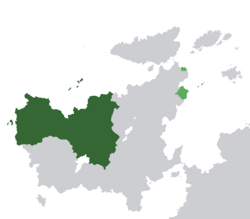Soravian Empire
This article is incomplete because it is pending further input from participants, or it is a work-in-progress by one author. Please comment on this article's talk page to share your input, comments and questions. Note: To contribute to this article, you may need to seek help from the author(s) of this page. |
Soravian Empire Зоравська імперія Zorav'ska imperiya | |||||||||||||||
|---|---|---|---|---|---|---|---|---|---|---|---|---|---|---|---|
| 1567–1857 | |||||||||||||||
| Motto: Король, країна та соціяріанство Korolʹ, krayina ta sotsiyarianstvo ("King, country and Sotirianity") | |||||||||||||||
| Anthem: "Слава Зоравському Імператору!" Slava Zoravs'komu Imperatoru! (1774–1806) ("Glory to the Soravian Emperor!") "Моя Батьківщина" Moya Bat'kivshchyna (1806–1840) ("My Fatherland") "Mарш об'єднаних Маролов'ян" Marsh ob'yednanykh Marolov'yan (1840–1857) ("March of the United Marolevs") | |||||||||||||||
| Capital and largest city | Samistopol | ||||||||||||||
| Official languages | Soravian Other spoken languages: Ambrazkan, Bistravian, Ilmenian, Kantemoshan, Laudanian, Lemovician, Miersan, Savader, Zalyk | ||||||||||||||
| Religion | 1848 census: 97.6% Sotirianity –– 86.8% Episemialist –– 8.4% Catholic –– 1.6% Amendist –– 0.8% Other 2.4% Other | ||||||||||||||
| Demonym(s) | Soravian | ||||||||||||||
| Government | Absolute monarchy | ||||||||||||||
| Emperor | |||||||||||||||
• 1567–1616 | Ivan IV (first) | ||||||||||||||
• 1616–1655 | Louis II | ||||||||||||||
• 1722–1756 | Frederick I | ||||||||||||||
• 1829–1861 | Ivan VI (last) | ||||||||||||||
| Minister-President | |||||||||||||||
• 1771–1790 | Wenceslaus von Alzen (first) | ||||||||||||||
• 1855–1857 | Matvei Mikhailitsyn (last) | ||||||||||||||
| Chancellor | |||||||||||||||
• 1710–1726 | Boris Loskutov-Savin (first) | ||||||||||||||
• 1769–1771 | Wenceslaus von Alzen (last) | ||||||||||||||
| Legislature | States-General | ||||||||||||||
| History | |||||||||||||||
• Proclaimed | 13 January 1567 | ||||||||||||||
• Colonisation of Chistovodia | 1500s | ||||||||||||||
| 9 March 1721 | |||||||||||||||
| 8 April 1855 | |||||||||||||||
| 4 January 1857 | |||||||||||||||
| |||||||||||||||
The Soravian Empire (Soravian: Зоравська імперія; Zorav'ska imperiya) was a historical state proclaimed in 1567 after the establishment of the Colony of Chistovodia by Grigori Kosh and lasting until the Soravian Revolution in 1857. At its territorial zenith it was the largest empire in continential Euclea and one of the world's largest empires, encompassing around 7,500,000 km2.
Successful colonies in Chistovodia and later Vinalia brought the lucrative fur trade to Soravia. Under the reign of Louis II, Soravia rapidly expanded its holdings in Asteria Superior, in the process enforcing widespread slavery and indentured servitude. Wealth from colonial trades elevated Soravia to one of Euclea's foremost economic and military powers, and in the 17th century it embarked on large-scale conquests of Laudania, Miersa and Bistravia coinciding with the decline of Imperial Amathia and Tengaria. This period also saw the Soravian capital Samistopol become the main centre of Marolevic and Episemialist intellectuals.
Soravia's alliance with Scovern eventually brought it into the Ten Years' War in 1711, where it was a major combatant both in Euclea and in the Asterias. After the war Soravia annexed the states of Kantemosha and rose to great power status at the expense of Estmere and the Rudolphine Confederation. The acquisition of Kassar in Satria brought Soravia to its territorial height in the 1750s. Soravia participated in the coalitions that toppled the Etrurian and Weranian republics in the early 19th-century, but by this time had been suffering with political unrest that ultimately introduced the Minister-President and a limited advisory government. An alliance with Gaullica and Valduvia culminated in the War of the Triple Alliance in the 1850s, which Soravia lost and was subsequently required to pay a large indemnity to the victorious powers. Economic destitution caused by the war and the autocratic rule of Ivan VI resulted in the Soravian Revolution that toppled the monarchy and established a republic in its place.
The Soravian Empire was predominantly ruled by members of the Weranian Halte-Herdorf cadet house, who also ruled the Principality of Wittislich in personal union until 1801. The Azmaran Confederation was administered by Frederick I in the mid-18th century.



